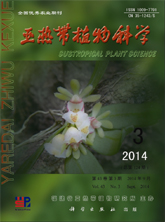|
|
Artificial燘reeding of Some Native燜ragrant Plants in Xiamen, Fujian Province
LIU Fu-ping,SONG Zhi-yu,ZHANG Xiao-hang
2014, 43(03):
251-254.
DOI: 10.3969/j.issn.1009-7791.2014.03.015
To play the effects of native fragrant plants of Xiamen on perfuming environment, four kinds of ornamental fragrant plant were tested on artificial breeding for improving their reproductive efficiency. In accelerating germination experiment of Michelia maudiae, it worked best that seeds were soaked with 300 mg·L-1GA3 at 50℃, the germination rate and germination potentiality were increased by 22.7% and 17.3%, respectively, as compared?to that of peeled seeds. The seed of Vitex trifolia var. simplicifolia which was accelerated germination with 1.0 g·L-1 GA3 at 50 ℃ had a best result, germination rate and germination potentiality were increased by 46.7% and 25.4%, respectively, than the control. In cuttage test the cuttings were pretreatmented with some plant growth regulators, and observed rooting rate, survival rate and average root number per cutting. Increase rates of three indexes were highest when Gardenia jasminoides cuttings pretreatmented with the solution of 100 mg·L-1 NAA and 100 mg·L-1 IBA, rooting rate and survival rate were increased by 18.7% and 15.8%, respectively, comparing?with the control, and the average root number per cutting were increased ?by 58.9%. It had the?best?] cuttage effect that Trachelospermum jasminoides cuttings soaked with the solution of 200 mg·L-1 NAA and 200 mg·L-1 IBA, the increase rates of rooting rate and survival rate were 24.5% and 19.1% respectively, compared to the control, and the increase rates of average root number per cutting was 66.7%.
References |
Related Articles |
Metrics
|
